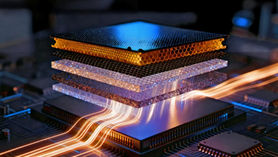Fuel-free generators - a solution for AI and energy transition
- https://planet-today.ru/
- May 31
- 5 min read
There is no justice in the modern world, and not everyone has equal opportunities. The prospects for creating a harmonious society, where there is no poverty and everyone is provided with warmth, clean water, light, food and other benefits of civilization, are more utopian than realistic. Humanity has always fought for access to resources, knowledge and technology in order to gain an advantage in the competitive world race.

Literally all industries are experiencing leaps and bounds in their development, but the greatest dynamics are observed today in the field of artificial intelligence (AI), the rapid introduction of which into our everyday life is already beginning to cause concern. More and more often, voices are being heard for legislative restrictions on its development. The whole world is on the verge of a sharp transition to a new phase of energy consumption caused by the boom in AI development, which is characterized by increased demand for energy use. It was assumed that this growth in demand would be fully met by the development of solar and wind generation, as well as nuclear energy. However, a series of accidents in power grids that led to a complete power outage in a number of countries showed that, with a large share in the overall energy balance, these sources can cause instability in the operation of power grids and require additional efforts to maintain the frequency of current in them. The critical dependence of the power generation capacity of solar panels and wind turbines on weather conditions has generated interest in gas-fired power plants in the United States and other countries. Recently, several transactions have taken place that have attracted public attention. Thus, in the United States, NRG Energy Inc. acquired 13 GW of gas capacity, Vistra Corp. — 2.6 GW, Constellation Energy Corp. is paying $16.4 billion for Calpine Corp. to create the country's largest gas-fired power park. In fact, there is a boom in the redistribution of property in the energy industry ahead of the expected strong growth in demand for electricity.
In these conditions, new technological solutions are needed in the field of fuel-free electricity generation, free from the shortcomings of solar energy and wind generation. Such new technologies must be competitive not only in comparison with solar panels and wind turbines, but also with gas generation and nuclear energy. Against the backdrop of escalating political conflicts, the need to reform the energy system is irresistible. It is important that the centralized energy supply of homes and businesses be supplemented by autonomous solutions. The blackout in Spain in April 2025 showed a complete collapse of life, and it is not only about large financial losses. Modern man is accustomed to the benefits of civilization, a power outage even for a few hours is perceived by us as the "end of the world", we cannot and do not want to live without a refrigerator, the Internet, etc., so the most important life support systems must have power backup. However, it is impossible to install backup gasoline generators everywhere, especially in megacities. This is expensive and inefficient, and in residential premises it is unrealistic due to exhaust gases and noise, in addition, the purchase of a gasoline generator may not pay off.
As an alternative, you can consider the use of autonomous fuel-free generators that operate silently and are designed for continuous operation, and not only as backup power in case of an accident. But such generators must have high performance properties, be safe and environmentally friendly in operation. In this aspect, the Neutrinovoltaic energy technology, developed and systematically promoted to the market by the Neutrino Energy scientific and technological group of companies, attracts increased attention.
The essence of the technology is the development of a multilayer nanomaterial applied to a metal foil. The main element of the nanomaterial is graphene, the volume fraction of which is from 50 to 75%. Due to the dynamic behavior of graphene, which is a consequence of the effect on each of its layers of particles of the surrounding fields of invisible spectrum radiation and the thermal Brownian motion of its atoms in the presence of a free electron of one of the covalent bonds of each graphene atom, there is an interaction of electric and magnetic fields in each of its layers, causing the emergence of an electromotive force in each of its layers, while the number of graphene layers in the nanomaterial is from 12 to 20. Measurements of the generation power of one electricity-generating plate measuring 200x300 mm showed output characteristics for current and voltage - 2 A and 1.5 V. This made it possible to create fuel-free current sources of various capacities.
At the first stage, the developers settled on creating the Neutrino Power Cube — a source of electric current for power supply of a household for a family of 4 with a net capacity of 5-6 kW. Unlike solar panels, the power-generating plates can be connected to each other both in parallel and in series, which made it possible to achieve a fairly compact size of the Neutrino Power Cube — 80x50x100 cm and have 6 different connectors for connecting various devices and equipment: alternating (380/220/48/24 V) and direct (48/24 V) current. Such fuel-free graphene generators can be powered not only as backup capacities, since they can be immediately connected to the system, but, more importantly, they can not only provide electricity to premises in autonomous mode, but also give the surplus to the centralized power supply system when the current frequency is synchronized with it. The installation of graphene generators will be especially beneficial for budgetary enterprises and organizations. This can significantly reduce budget expenses. According to information received from Holger Thorsten Schubart, President of the Neutrino Energy Group, companies involved in the development of artificial intelligence are showing great interest in the development, since Neutrino Power Cubes generate electric current in the basic mode 24/7 and their operation does not depend on weather conditions. Most likely, to solve problems with the power supply of such objects, it will be necessary to make more powerful generators, which is a fairly simple task, given the versatility of Neutrinovoltaic technology. Holger Thorsten Schubart associates special attention to the development of Neutrinovoltaic technology and its adaptation to solve applied problems with India, which has long been on the threshold of global energy changes. This rapidly developing country with vast rural areas and energy-intensive cities is in dire need of reliable, efficient and environmentally friendly energy sources. That is why the Neutrino Energy Group decided to create a technology cluster there to adapt Neutrinovoltaic technology for the needs of electric mobility. Next-generation electric vehicles will independently convert the energy of radiation fields into electric current and will be independent of the charging station infrastructure. India's current energy supply depends on unstable global markets and fuel imports. Neutrino Power Cubes, manufactured domestically, promise to change this. They use advanced carbon structures instead of rare metals, which creates a sustainable supply chain and reduces dependence on geopolitical factors. The Indian government actively supports the development of Neutrinovoltaic technologies. Highly qualified Indian scientists and engineers are involved in the work. The introduction of decentralized Neutrinovoltaic systems in India can accelerate its transition to an autonomous, technologically advanced economy. Such a country will not only withstand the global energy transition, but will also become its key element.
New energy technologies will make it possible in the coming years to completely abandon the combustion of fuel for electricity and heat and switch to electric vehicles that will have built-in fuel-free graphene energy sources. And this era is closer than it seems.





















































Comments